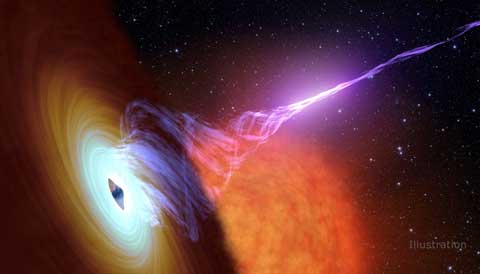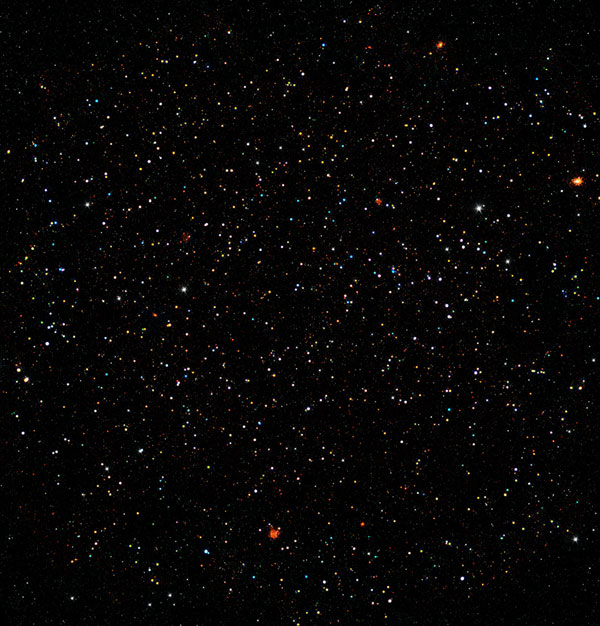How did supermassive black holes form? Two studies discovered dozens of middling-mass black holes in dwarf galaxies to fuel an ongoing debate.
Heavyweight black holes are a surprisingly common feature of the universe, lurking or blazing in galaxies near and far. But a question has long troubled astronomers: Where did these so-called supermassive black holes — typically ranging in mass from millions to billions of Suns — come from? Two studies using X-ray observations give two different answers.
Past & Present

NASA / JPL-Caltech
When the universe was less than a billion years old, galaxies were already hosting supermassive black holes, visible by the glowing gas they gobbled down at rates of dozens of Suns per year. Even when gorging at that rate, though, the typical way we know of to make a black hole — the collapse of a dying star — wouldn’t suffice to create such beasts.
There are two solutions currently at the forefront of solving this dilemma: One idea is that the first generation of stars that gave birth to black holes were far more massive than the modern version, typically containing 100 Suns’ worth of mass. These 100-solar-mass black holes would then have to feed at tremendous rates pretty much all the time to grow to supermassive size by the time the universe reaches 1 billion years old.
An alternative idea is that the first black holes formed when a gas cloud directly collapsed into something between up to a thousand times the mass of the Sun. This scenario needs a pretty special situation to grow such massive black holes, to keep all the gas together as it’s collapsing without having it fragment into stars. (See Camille Carlisle's feature, "The First Black Holes," in the January 2017 issue of Sky & Telescope for more detail on these scenarios.)
Current technology won't let us actually test either scenario, so astronomers take a roundabout route to look for the answer. If the supermassive black holes that inhabit large galaxies start their lives as stellar-mass black holes, then smaller, “intermediate-mass” black holes should be common in smaller galaxies. The direct-collapse scenario instead predicts that such middling black holes would be rare. So all astronomers have to do is tally up the black holes in dwarf galaxies and they have their answer — but that's not as easy as it sounds.
Tallying the Middleweight Division
Mar Mezcua (Institute of Space Science, Spain) and colleagues pored through X-ray images collected as part of the Chandra COSMOS Legacy Survey, which also includes visible-light and infrared data. They find 40 dwarf galaxies hosting actively feeding, middleweight black holes with masses between 10,000 and 100,000 Suns. The team uses the fraction of “active” black holes — roughly 10% — as a proxy for the total number of black holes in dwarf galaxies. The low fraction, they argue in the August 1st Monthly Notices of the Royal Astronomical Society, favors the direct-collapse model.

X-ray: NASA/CXC/ICE/M.Mezcua et al.; Infrared: NASA/JPL-Caltech; Illustration: NASA/CXC/A.Hobart
Another point in favor of the direct-collapse scenario is that it predicts that smaller galaxies should be less likely to host black holes, and that is exactly what Mezcua and colleagues find. But the fraction of active black holes that the team calculates is in reality a lower limit on the true number of black holes. It could be that huge numbers of fasting black holes, silent in X-rays, lurk undetected in other dwarf galaxies.
Adding to the debate are new data from Igor Chilingarian (Smithsonian Astrophysical Observatory) and colleagues, who data-mined sky surveys to find a sample of 305 middling-mass black hole candidates, published August 6th in the Astrophysical Journal. They confirm 10 of these candidates with new and archived X-ray observations from Chandra, XMM-Newton, and Swift, estimated to have masses between 30,000 and 200,000 Suns.
Chilingarian argues that the mere existence of intermediate-mass black holes on the lower end of this mass spectrum favors the stellar-seed scenario, as the direct-collapse scenario ought to produce only black holes with more than 100,000 Suns’ worth of mass. But Mezcua disagrees, arguing that the direct-collapse models are flexible enough to allow for smaller masses.
For now, the contest ends in a tie, and that’ll probably remain the case until astronomers can figure out a way to find dormant black holes in dwarf galaxies.
“The methods used to measure black hole masses or to infer the presence of a black hole in massive galaxies with dormant black holes cannot be applied to dwarf galaxies, because these are small and faint compared to massive elliptical galaxies,” Mezcua says. “So if detecting active black holes in dwarf galaxies is difficult, detecting the dormant ones is even more challenging.”
Amy Reines, whose 2013 study also favored the direct-collapse model with the same caveats as the study from Mezcua's team, agrees. “I don't think there is conclusive evidence one way or the other,” says Amy Reines (Montana State University). “More work needs to be done.”
 2
2









Comments
Ken-Winters
September 5, 2018 at 12:40 am
Occam's razor is a guideline, not a rule of physics. It is quite possible that both methods of forming high-mass black holes are correct, some form by one method, some by the other. One thing I feel sure of: we won't know the answer(s) for some time yet.
You must be logged in to post a comment.
DC0
December 18, 2019 at 2:46 pm
Monica Young,
Why a Black Star Could Be the Alternative To a Black Hole
Using the black hole model while it’s contraction, the radius reduces to an infinitely small point to where both the gravitational pressure and the density go to infinity. This infinitely small point is called a singularity. Many scientists believe that if the solution to a black hole ends up being infinity or having a singularity, the solution is not valid. The black star model does not create a singularity.
Due to a unique condition of creating black stars by freezing space and time from the center to the surface, the conventional method of deriving a black hole from general relativity could not be used. To solve the problem, the Newtonian model, while factoring in relativistic corrections derived from general relativity, was used. This mathematical method, with the aid of Excel, takes about a day to run. While trying to create the model of a black hole, it unexpectedly, led to the creation of a black star. A black star is like a black hole except that it is made up of frozen in time matter. This freeze holds the matter in place and creates a black star with no singularity. The freezing of time relatively stops the contraction of this matter at a fairly uniform density. Each black star size ends up with a unique density. It’s this density, which is a function of the black star size, that helps to answers questions like:
1. Why doesn’t a black star have a singularity?
2. Why are larger black stars less dense than smaller ones?
3. Why is a black star created at fairly uniform density?
4. Why are there no stellar created black stars smaller than 2.2 solar masses?
5. Why are there no stellar created black stars larger than 15 solar masses?
6. Why does the smallest supermassive black star size start at 50,000 solar masses?
7. Why is there such a large size gap between stellar black stars and super massive black stars?
8. Why is there also such a large density gap between them?
9. Why are stellar black stars made up of neutron matter?
10. Why are supermassive black stars made up of normal matter?
11. Why is the density gap between stellar black stars and supermassive black stars the same as the density gap between neutron matter and normal matter?
12. Why are all supper massive black stars larger than 4 million solar masses, only created in the early universe by a direct collapse of hydrogen without the interference of fusion?
13. Why are supermassive black stars typically made before the stars in a galaxy?
These questions cannot be answered using black holes that have a singularity, but they are answered by this model of creating black stars. The generated information agrees with observations when available. This might even be proof of the existence of black stars and the nonexistence of black holes.
And now, the rest of the story.
You can see this complete episode of black stars at:
https://NeutronStarsAndBlackStars.com
Comments would be appreaciated.
David Clark
You must be logged in to post a comment.
You must be logged in to post a comment.